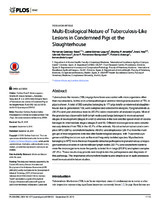Multi-Etiological Nature of Tuberculosis-Like Lesions in Condemned Pigs at the Slaughterhouse
Autor
Cardoso-Toset, Fernando
Gómez-Laguna, Fernando
Vela, Ana I.
Fernández-Garayzábal, F.
Luque-Moreno, Inmaculada
Amarilla, Shyrley P.
Carrasco Otero, Librado
Astorga Márquez, Rafael J.
Editor
Public Library of ScienceFecha
2015Materia
Tuberculosis-like lesionsTBL
Pigs
METS:
Mostrar el registro METSPREMIS:
Mostrar el registro PREMISMetadatos
Mostrar el registro completo del ítemResumen
Tuberculosis-like lesions (TBL) in pigs have been associated with microorganisms other
than mycobacteria. In this work a histopathological and microbiological evaluation of TBL in
pigs is shown. A total of 352 samples belonging to 171 pigs totally condemned at slaughterhouse
due to generalized TBL were sampled and selected for analysis. Pyogranulomatous
(56.2%) and granulomatous lesions (20.2%) were observed in all analysed organs. Most of
the granulomas observed in both lymph nodes and lungs belonged to more advanced
stages of development (stages III and IV) whereas in the liver and the spleen most of lesions
belonged to intermediate stages (stages II and III). Different microorganisms were simultaneously
detected from TBL in the 42.7% of the animals. Mycobacterium tuberculosis complex
(MTC) (38%), coryneform bacteria (40.3%) and streptococci (28.1%) were the main
groups of microorganisms detected after bacteriological analysis, with Trueperella pyogenes
and Streptococcus suis as the most frequently isolated species. Mycobacteria
belonging to MTC were the most frequently detected pathogens in granulomatous and pyogranulomatous
lesions in submandibular lymph nodes (32.7%) and coryneform bacteria
were the microorganisms more frequently isolated from lungs (25.9%) and spleen samples
(37.2%). These results may provide new insights into the pathogenesis and diagnosis of
this pathology. The importance of coryneform bacteria and streptococci in such processes
must be evaluated in future studies

